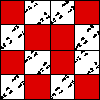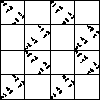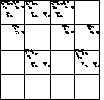






Recall the method of driving an IFS by a time series. To develop some practice in interpreting these graphics, we drive the IFS with the tent map and the logisitc map.
We use equal-size bins.
 |
First, we drive an IFS by the |
 |
To begin to understand this picture, we
determine the empty length 2 addresses
for the |
 |
Now drive an IFS randomly, except forbid the pairs that
are forbidden in the s = 4 logistic map. We get the same picture as with the
|
 |
Another way to see this is to apply the deterministic IFS rules, but imposing the forbidden combinations. |
 |
Now we drive an IFS by the |
 |
For comparison we drive an IFS by the
|
 |
Now drive an IFS randomly, except forbid the pairs that
are forbidden in the |
Return to Deterministic Chaos.